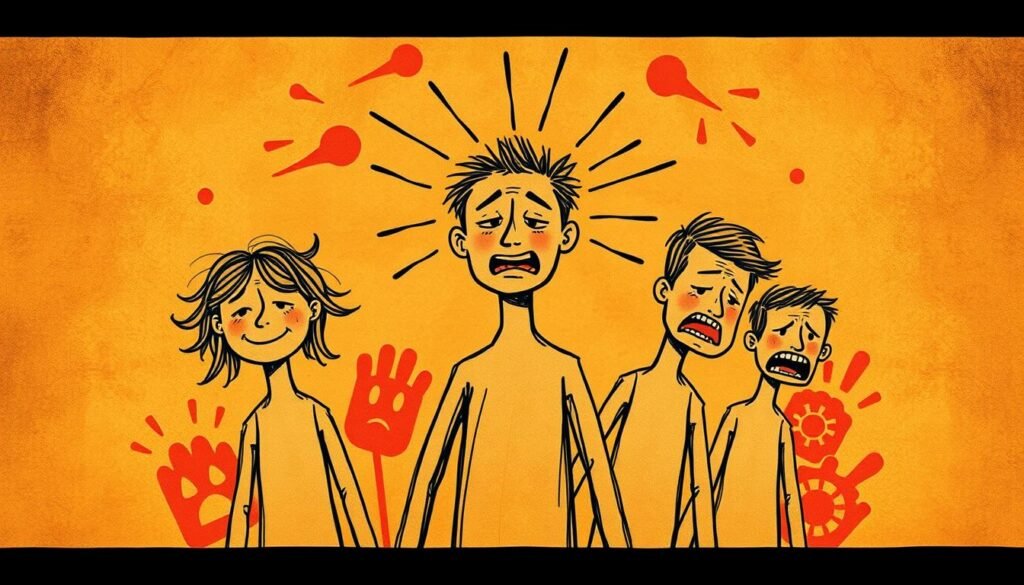Have you ever wondered why some people seem to handle life’s ups and downs with ease, while others struggle? The answer often lies in understanding emotions and feelings. These play a crucial role in shaping our daily lives and overall mental health.
Paul Ekman’s Atlas of Emotions categorizes five main types, providing a foundational framework. Surprisingly, a 2017 study revealed 27 distinct categories, showing how complex these experiences can be. Recognizing them is the first step toward effective management.
Emotional awareness is not just about the mind; it also involves the body. Physical manifestations, like a racing heart or tense muscles, often signal underlying feelings. By tuning into these cues, you can better navigate your health and well-being.
Practical tools for managing these experiences are accessible to everyone. From mindfulness techniques to journaling, small changes can make a big difference. Let’s explore how you can take control and thrive.
Key Takeaways
- Emotional intelligence is increasingly important in modern life.
- Paul Ekman’s Atlas of Emotions identifies five main types.
- A 2017 study revealed 27 distinct emotion categories.
- Emotional awareness is linked to better mental health.
- Physical signs in the body often reflect underlying feelings.
- Practical tools for emotional management are accessible to everyone.
What Are Emotions and Feelings?
Life’s challenges often trigger instant responses, but what happens next shapes our experiences. Understanding the difference between immediate reactions and lasting interpretations can transform how you navigate daily life.
Defining Emotions and Feelings
Emotions are quick, physiological responses like a racing heart or sweating. These are survival mechanisms, such as the fight-or-flight response, designed to protect us. Feelings, on the other hand, are conscious interpretations that last longer. For example, surprise can turn into anger based on how we process the situation.
Research from Aalto University, led by Lauri Nummenmaa, shows where these experiences manifest physically. A body map highlights areas like the stomach for love or tension in muscles for stress. This study reveals how deeply our physical state is tied to our inner world.
The Role of Emotions in Daily Life
Our reactions often happen unconsciously, while feelings form through conscious thought. This process influences how we interact with others and make decisions. For instance, butterflies in the stomach might signal excitement or nervousness, guiding our actions.
Understanding these signals can improve mental health and relationships. By recognizing physical indicators, like muscle tension or a racing heart, we can better manage our responses. This awareness helps us thrive in both personal and professional settings.
Why It’s Important to Understand Your Emotions
Understanding your inner world can transform how you handle life’s challenges. It’s not just about reacting; it’s about interpreting and managing your responses effectively. This skill is vital for maintaining mental health and fostering healthy relationships.
The Impact of Emotions on Mental Health
Research from the University of Kansas shows that emotional awareness can reduce inflammation in cancer patients. This highlights the physical benefits of understanding your mental state. Similarly, George Mason University found that clarity in interpreting emotions lowers the risk of substance abuse.
Stress and anxiety often stem from maladaptive patterns. Recognizing these patterns can help you address them before they escalate. For example, prolonged stress can lead to depression, while unchecked anxiety can cause chronic health issues.
How Emotions Influence Relationships
Emotional contagion plays a significant role in interactions. Studies show that 40% of communication is conveyed through tone, not words. This means your mood can directly affect those around you.
The Gottman Institute identifies four markers of relationship conflict, known as the “Four Horsemen.” These include criticism, defensiveness, contempt, and stonewalling. Understanding these can help you navigate disagreements more effectively.
Improved empathy and conflict resolution are just a few social benefits of emotional awareness. These skills can deepen intimacy and reduce feelings of loneliness.
According to the CDC, stress-related healthcare costs in the U.S. reach $300 billion annually. By managing your emotions, you can contribute to reducing this burden and improving overall well-being.
The 5 Main Categories of Emotions
The way we process our inner experiences can shape our daily interactions and decisions. Paul Ekman’s research identifies five core types of emotional responses. These are universal across cultures, highlighting their fundamental role in human behavior.
Berkeley’s study expanded this framework, revealing 27 distinct emotional gradients. This shows how nuanced our inner world can be. Understanding these categories helps us better manage our responses to life’s challenges.
Enjoyment: The Emotion of Happiness
Enjoyment is often linked to positive experiences like success or connection. Cultural variations exist, with Eastern societies emphasizing collective joy, while Western cultures focus on individual happiness. Recognizing this can enhance our ability to cultivate positivity.
Sadness: Understanding Grief and Loss
Sadness is a natural response to loss or disappointment. Prolonged sadness, as defined by DSM-5 criteria, can lead to depression. Acknowledging this emotion helps in seeking timely support and healing.
Fear: Responding to Threats
Fear is a survival mechanism triggered by perceived threats. The amygdala plays a key role in this response, as shown in MRI studies. Managing fear involves understanding its root causes and developing coping strategies.
Anger: Managing Frustration and Conflict
Anger often arises from unmet expectations or perceived injustices. Workplace statistics show that 29% of employees experience weekly frustration episodes. Learning to channel anger constructively can improve relationships and productivity.
Disgust: Reacting to Unpleasant Situations
Disgust ranges from mild dislike to intense phobic reactions. This emotion helps us avoid harmful situations. Understanding its spectrum can aid in managing aversive responses effectively.
How to Identify Your Emotions
Identifying your inner experiences can be a powerful step toward better mental health. Recognizing what you’re experiencing in the moment helps you respond effectively. This process involves tuning into both physical and mental signals.
Recognizing Physical and Emotional Cues
Your body often provides clues about your inner state. For example, sweaty palms might signal anxiety, while a clenched jaw could indicate anger. These physical cues are essential for understanding your responses to situations.
Body scanning meditation is a helpful technique. It involves focusing on different parts of your body to identify tension or discomfort. This practice can enhance your awareness of subtle signals.
Using Tools Like the Atlas of Emotions
Paul Ekman’s Atlas of Emotions is a valuable resource. This interactive tool breaks down emotional components into clear categories. It helps you map your experiences and understand their origins.
Mood tracking apps like Moodnotes and Daylio are also useful. With over 2.5 million users, these apps allow you to log your thoughts and patterns over time. They provide insights into recurring themes and triggers.
Journaling prompts can further aid in emotional recognition. Writing about your experiences helps you process and identify recurring patterns. This practice fosters deeper self-awareness and growth.
Strategies for Managing Emotions
Managing your inner responses effectively can lead to a more balanced and fulfilling life. Whether you’re dealing with stress, anxiety, or frustration, there are proven strategies to help you navigate these challenges. This section explores practical tools to enhance your emotional well-being.
Practicing Mindfulness and Self-Awareness
Mindfulness is a powerful tool for reducing stress and improving self-awareness. Research from the NIH shows that mindfulness practices can lower stress levels by 31%. Techniques like body scanning meditation help you tune into physical cues, such as muscle tension or a racing heart.
Dialectical Behavior Therapy (DBT) offers the PLEASE skill for emotional regulation. This acronym stands for Physical health, Eating, Avoiding mood-altering substances, Sleep, and Exercise. Incorporating these habits into your routine can stabilize your mood and improve overall well-being.
Developing Healthy Coping Mechanisms
Healthy coping mechanisms are essential for managing intense reactions. Evidence-based techniques like progressive muscle relaxation and box breathing can reduce anxiety and frustration. These methods help calm the nervous system and restore balance.
Heart Rate Variability (HRV) biofeedback training is another effective approach. It teaches you to regulate your physiological responses, making it easier to manage stress. Workplace emotional intelligence training programs also equip employees with skills to handle challenging situations.
Seeking Support from Others
Sometimes, professional support is necessary to navigate complex emotions. The Crisis Text Line, which handled over 10 million conversations in 2022, is a valuable resource for immediate help. Therapy options like Cognitive Behavioral Therapy (CBT) and Acceptance and Commitment Therapy (ACT) have high effectiveness rates for managing anxiety and stress.
According to NIMH guidelines, seeking professional help is crucial when emotional challenges interfere with daily life. Building a support network of friends, family, or therapists can provide the guidance needed to thrive.
The Difference Between Emotions and Feelings
Our inner world operates on two distinct levels: immediate reactions and deeper interpretations. Understanding this difference can transform how we manage our responses to life’s challenges. While immediate reactions are quick and instinctive, deeper interpretations shape our long-term experiences.
How Immediate Reactions Evolve into Lasting Interpretations
Dr. Jill Bolte Taylor’s research highlights that immediate reactions last about 90 seconds chemically. These are quick, instinctive responses triggered by the amygdala. For example, fear might make your heart race when you hear a loud noise.
Over time, these immediate reactions evolve into lasting interpretations. This happens through rumination, where the prefrontal cortex processes the experience. For instance, fear might turn into anxiety if you dwell on the event.
Why This Distinction Matters
Understanding the difference between immediate reactions and lasting interpretations is crucial. It helps us avoid emotional hijacking, where intense reactions cloud judgment. For example, stock traders often make poor decisions when driven by immediate fear rather than rational analysis.
This distinction also aids in managing long-term responses. Mindfulness studies by Ellen Langer show that reappraising immediate reactions can reduce their impact. Practicing emotional granularity—identifying specific feelings—can lead to better mental health.
By recognizing the process of how immediate reactions evolve, we can take control of our inner world. This awareness helps us make better decisions and build healthier relationships.
How Emotions Affect Your Body and Behavior
The connection between your inner world and physical state is more profound than you might realize. Your body and behavior are deeply influenced by your mental responses. Understanding this link can help you make better decisions and improve your overall health.
The Physical Impact of Emotions
Chronic stress can take a toll on your body. According to the American Heart Association, it increases the risk of heart disease by 40%. Cortisol, the stress hormone, plays a key role in this process. Elevated levels can lead to emotional eating patterns and weight gain.
Psychosomatic disorders, such as irritable bowel syndrome (IBS) and tension headaches, are also linked to prolonged stress. These conditions highlight how your mental state directly affects your physical well-being. Recognizing these responses is the first step toward managing them effectively.
How Emotions Drive Decision-Making
Your mental state significantly influences your choices. Antonio Damasio’s somatic marker hypothesis explains how gut feelings guide decisions. For example, loss aversion often leads people to avoid risks, even when the potential reward is high.
Emotion-driven consumer behavior is another example. Studies show that 95% of purchasing decisions are subconscious, driven by feelings rather than logic. Understanding this can help you make more intentional choices in both personal and professional settings.
Workplace productivity is also tied to emotional states. Employees who manage stress effectively are 31% more productive. Biohacking techniques, like mindfulness and HRV training, can help maintain emotional homeostasis and improve performance.
Conclusion
Taking control of your inner world can lead to a healthier, more balanced life. Frameworks like Paul Ekman’s Atlas of Emotions provide a clear roadmap for understanding your responses. Clinical research supports the benefits of emotional awareness, linking it to improved mental health and stronger relationships.
Start by implementing identification strategies, such as journaling or mindfulness. These tools are accessible and effective for managing daily stress. If needed, professional resources like therapy or support groups are widely available to guide you.
Your journey toward emotional growth is ongoing. Small, consistent steps can transform how you navigate challenges. Embrace this process, and you’ll unlock the potential for a more fulfilling life.
FAQ
What is the difference between emotions and feelings?
Emotions are immediate, instinctive reactions to stimuli, while feelings are the conscious interpretation of those reactions over time. For example, fear is an emotion, but the lingering unease afterward is a feeling.
Why is it important to understand my emotions?
Recognizing and managing your reactions can improve mental health, strengthen relationships, and help you make better decisions in stressful situations.
What are the main types of emotions?
The five primary categories include happiness, sadness, fear, anger, and disgust. Each plays a unique role in how we respond to life’s challenges.
How can I identify what I’m feeling?
Pay attention to physical cues like a racing heart or tension, and use tools like the Atlas of Emotions to better understand your responses.
What are some strategies for managing intense reactions?
Practice mindfulness, develop healthy coping mechanisms like deep breathing, and seek support from trusted friends or professionals when needed.
How do emotions affect my body?
They can trigger physical responses like increased heart rate, sweating, or muscle tension, which influence overall health and behavior.
Can emotions impact my relationships?
Yes, how you express and manage your reactions can strengthen or strain connections with others, making emotional awareness crucial for healthy interactions.
What role does sadness play in emotional health?
Sadness, often linked to grief or loss, helps process difficult experiences and can lead to personal growth when managed effectively.












